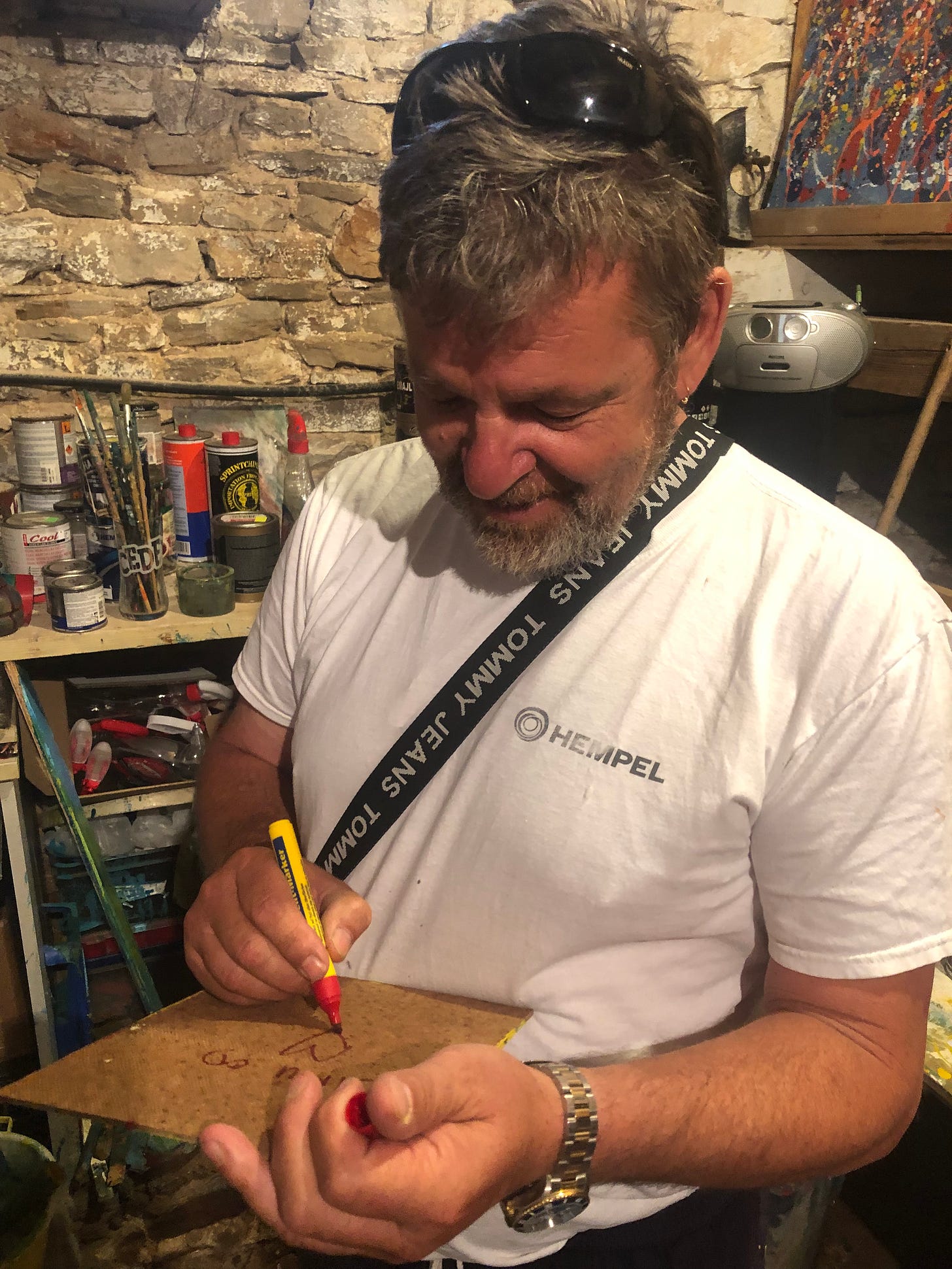When you walk into Vicko Buktenica’s studio, the initial impression is that a dozen paint cans exploded. The floor is splattered and swirled with layers upon layers and brightly colored paint.
But as I looked around, I found finished works with distinct and consistent styles. The paintings were abstract but somehow all projected joy. At least that’s what I felt.
A few weeks ago, I hadn’t even heard of “naïve art.” I passed a sign in Zagreb for the Croatian Museum of Naïve Art, and I thought it was a typo. Shouldn’t it be Native Art?
No, it shouldn’t. Naïve art is a major art form in Croatia and has been since the 1930s. It was first the work of peasants, fishermen, farmers and other “ordinary” people who were self-taught yet created art works of a professional level.
As the Museum itself defines it, “Naïve art, or, simply, the Naïve, is the work of self-taught artists who have never been to art school but who with their works have achieved a recognisable style and personal poetics as well as a high degree of artistic worth, which distinguishes them from amateurs and dilettantes and vernacular and folk painters and sculptors.”
In a country where social class often determined whether or not a person could have formal art training or even a complete education, naïve art helped break down the barriers. It was no longer just the wealthy and nobility who created art. It was symbolic of the democratic system the country yearned for. It was about talent, not privilege.
At its core, naïve art is still created by artists with no formal art training. It’s not the same as amateur art but rather presents itself with the artists’ distinctive creative styles. It is often considered childlike and simple and frequently ignores the “rules” of painting relative to distance, perspective and color.
And Vicko, in tiny Grohote village on Croatia’s Solta island, may be one of the most talented and prolific naïve artists in Croatia, likely well beyond.
It was still an abstract concept for me–until I navigated myself through the maze of Grohote’s narrow stone-house-lined streets and entered Vicko’s studio. That feeling grew when we went upstairs to his gallery.
About a third of the paintings might fall under “abstract expressionism” with colors dripped, layered and swirled in a style reminiscent of Jackson Pollock. Another third were simple representations of daily life, much akin to the American primitive style of Grandma Moses. Donkeys, sailboats and owls (the symbol of Solta) are primary subjects. I’d call much of the remaining paintings “fusion,” a combination of his two art forms.
Some of the works are those of Vicko’s late uncle, Eugen Buktenica Đenko, who helped pioneer naïve art in Dalmatia. Before he died, he bequeathed his house to Vicko to open Buktenica & Buktenica Gallery and continue the painting tradition.
Ironically, Vicko’s style may in fact reflect an incident in his childhood. A teacher looked at one of young Vicko’s paintings and told him he’d never be an artist. Better a farmer or a fisherman. Shattered by the criticism, Vicko gave up on the idea of becoming an artist or going to art school. He also didn’t even finish elementary school.
One evening, he put a canvas on an easel and a brush in his hand. And did nothing. “Who am I to think I can do this?,” he asked himself. He tried a few times. Nothing.
Then, one night, he didn’t go to sleep and just started painting. And so it began.Inspired by his uncle’s paintings and the colorful world around him, however, he says something clicked. He started painting in the styles he’s known for today. Painting gave him joy and soon became the centerpiece of his life.
He rarely sells any of his works–just from time to time if he’s facing a big expense. Or to support programs for disabled children on the island. The art comes from his heart and soul and nourishes his heart and soul.
Vicko doesn’t limit himself to canvas. Large wooden crucifixes, furniture, driftwood, and even a toilet seat, a bed pan and a trash can outside carry his signature abstract style. He also designed the label for a popular Soltan wine, Orgazam. Tagline: “Wine for better sex.”
Before I left the gallery, Vicko asked me to pick out a painting I’d like to take with me. It was a tough choice. But finally I saw one that sang to me. I told him, “I didn’t choose it. It chose me.”
He hugged me and then signed the back of it and inscribed it “To Jim” with a heart underneath. It will take a place of honor in my home.










i say that with my shepherd dog Huron i didnt choose him he chose ME!